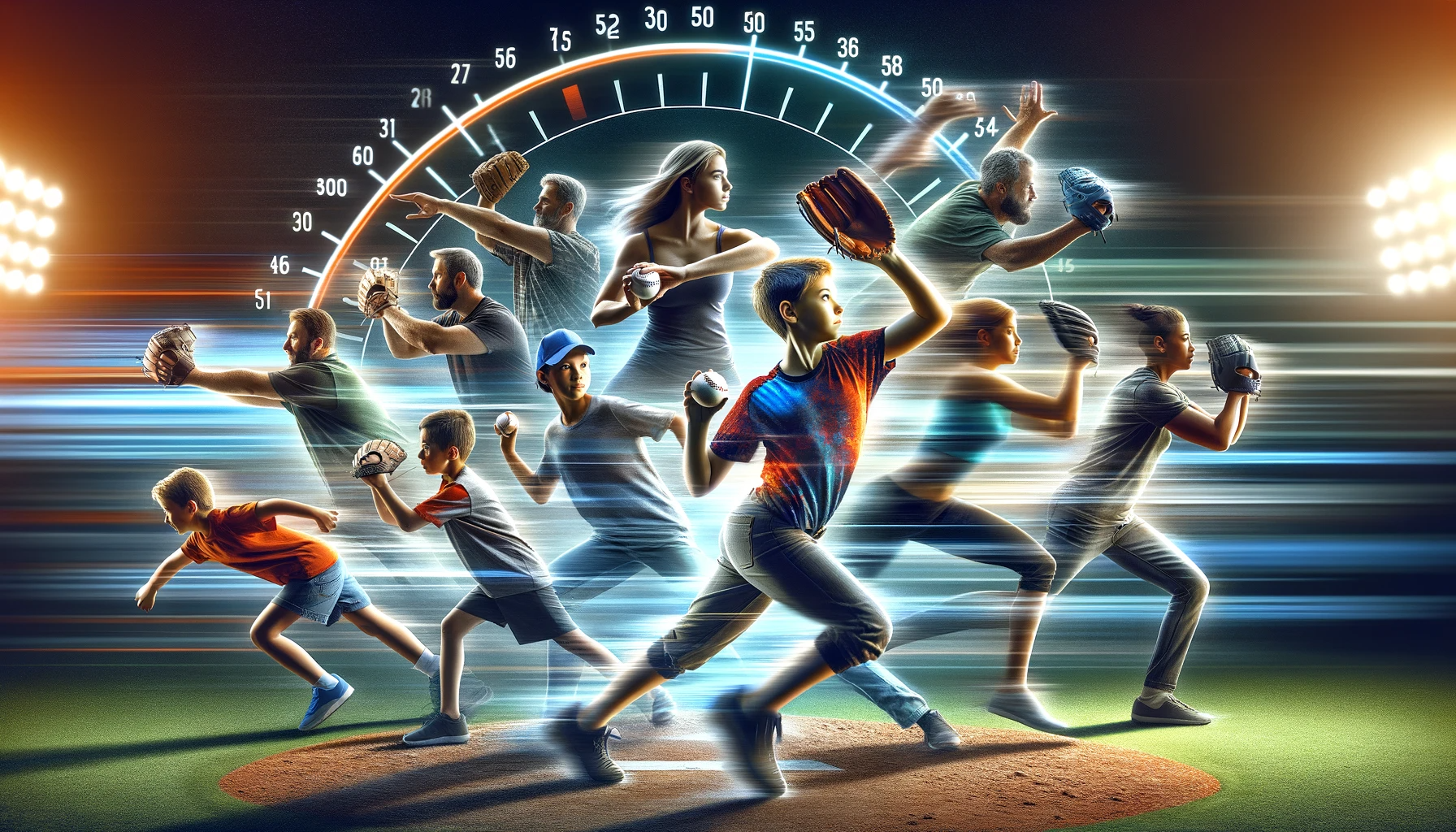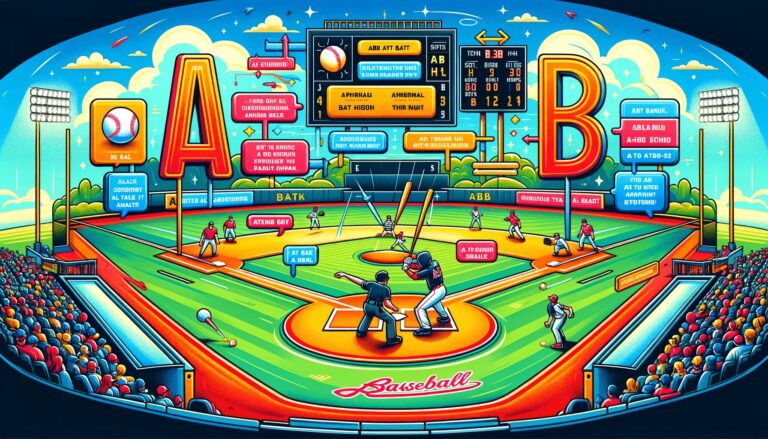How Fast Can The Average Person Throw a Baseball?
On average, a typical person can throw a baseball at a speed of about 45 to 65 miles per hour. This speed can vary widely depending on several factors like the age range, strength, and experience in throwing.
In this article, we’ll explore what affects throwing speed, how you can improve yours, and how you compare to professional players.
Let’s explore the elements that contribute to how hard and fast you can pitch that baseball to home plate.
Key Takeaways
- The average fastball velocity in Major League Baseball has increased from about 89 mph in 2002 to over 93 mph in 2022, with records surpassing 105 mph.
- The pursuit of higher pitch speeds, known as the ‘velocity trap,’ has led to a near-linear relationship between pitch speed and swinging strikes, enticing players to risk injury for the sake of performance.
- Biomechanical expertise and training techniques are crucial for pitchers to achieve and sustain high velocities while minimizing the risk of injury.
- Effective pitching is not solely dependent on velocity; control, movement, and pitching intelligence play significant roles in a pitcher’s success.
- Amateur pitchers, including the ‘average Joe,’ can work to improve their pitching speed, but must consider their physical limitations and prioritize safe training practices.
The Evolution of Pitching Speed
From Chimpanzees to Fastballs: The Human Arm’s Transformation
The human arm has undergone a remarkable evolutionary journey, transforming from a limb unsuited for overhand throwing to one capable of launching a baseball at breathtaking speeds.
The average fastball in Major League Baseball has seen a significant increase in velocity over the years, with speeds averaging around 89 mph in 2002 and climbing steadily since then.
This increase in pitching speed is not without its consequences. As pitchers push the limits of their arms, the rate of catastrophic injuries, particularly UCL tears, has risen sharply.
The correlation between fastball velocity and arm injuries is stark, with injury statistics mirroring the upward trend in pitch speeds.
Despite the risks, the allure of high-velocity pitching continues to drive players and the sport forward.
The evolution of pitching is a testament to both human potential and the delicate balance between pushing boundaries and preserving health.
Historical Trends in Major League Baseball Velocity
Over the past two decades, the average fastball velocity in Major League Baseball (MLB) has seen a significant uptick.
In 2002, the average fastball hummed in at around 89 mph. By 2012, this number had climbed to 91.6 mph, and in little league a decade later, in 2022, it reached 93.6 mph.
This steady increase reflects a broader trend in the sport towards greater speed and power.
The quest for velocity has not been without its milestones. Aroldis Chapman set a formidable record with a pitch at 105.8 mph in 2010, a record that remarkably still stands.
Last year, Jhoan Duran of the Minnesota Twins led the MLB with an average fastball velocity of 101.8 mph, underscoring the ongoing pursuit of speed in pitching.
However, this surge in velocity comes with a parallel rise in injury rates. Experts like Glenn Fleisig have pointed out that the increase in arm injuries is almost in lockstep with the rise in pitch speeds.
The implications are clear: as pitchers push the envelope on velocity, the physical toll on their arms intensifies.
The Impact of Pitching Speed on Game Dynamics
The relentless pursuit of higher pitch speeds has reshaped the dynamics of baseball. Pitch speed is a significant factor in the game, affecting the outcome of pitches, the strategies of batters, and overall game dynamics.
As pitchers hurl fastballs exceeding 100 mph, the margin for error for batters narrows, leading to a rise in swinging strikes and a shift in hitting approaches.
- The prevalence of high-velocity pitches has led to an evolution in the types of pitches thrown. Off-speed pitches like sliders and sinkers are now delivered with the same ferocity as traditional fastballs.
- The introduction of the pitch clock in the minor leagues and its potential adoption in the majors could condition a new generation of pitchers to maintain high speeds under increased time constraints.
However, the obsession with velocity also comes with a caveat. While it’s clear that velocity can dominate, control remains paramount.
A pitch that’s fast but not strategically placed can be as much of a liability as an asset. The game’s current pitch velocity and trend continue to provoke debate on the balance between speed and skill.
Read Also: How Many Acres in a Baseball Field
The Velocity Trap: Risks and Rewards
The Lure of the Radar Gun for Aspiring Players
The allure of the radar gun in baseball is undeniable. Young players, from Little Leaguers to top high school baseball prospects, often focus heavily on velocity.
They believe that the key to their future success lies in the numbers flashing on that screen.
The higher the velocity, the brighter their prospects for a college scholarship or a professional contract seem to be.
- The radar gun has become a symbol of potential and power in the game.
- Aspiring players are frequently more focused on velocity than on the art of pitching itself.
- The pursuit of speed can overshadow the importance of control, strategy, and overall effectiveness on the mound.
This obsession with more throws and speed is not without consequences. The drive to throw harder can lead to overexertion and, ultimately, injury, especially in young arms not yet fully developed for such strain.
Despite the risks, the dream of hitting triple digits on the radar gun continues to inspire countless players to push their limits, often at the expense of their long-term health and performance.
The Trade-Offs of High-Speed Pitching
In the quest for lightning-fast pitches, the balance between risk and reward is a tightrope walk for pitchers.
On one hand, the allure of the radar gun and the competitive edge that comes with high velocity are undeniable.
On the other, the physical toll of consistently throwing at maximum effort can lead to a range of injuries.
- Velocity wins in the game, but at what cost? The pursuit of speed often comes with an increased risk of arm injuries, as the human arm is pushed to its limits.
- The shape and manipulation of pitches, such as sliders and sinkers, add another layer of complexity and risk when thrown with maximum force.
- While high velocity can lead to more swinging strikes, it’s not a silver bullet. Control and the ability to actually ‘pitch’ can be just as important as sheer speed.
The velocity trap is a complex issue with many factors involved. Programs like MLB’s Pitch Smart aim to reduce risks for young players.
However, the debate continues on balancing speed pursuit with pitchers’ health and longevity.
Injury Rates to Rising Fastball Velocities
As fastball velocities have soared to new heights, so too have the rates of arm injuries among professional pitchers.
The average fastball speed has jumped significantly, from 90.5 mph in 2008 to a staggering 93.9 mph in 2022, with a high school pitchers peak over 94 mph.
This increase in average speed, has been accompanied by a worrying trend in arm injuries, particularly UCL tears, which have become alarmingly common.
The link between high-velocity pitching and arm injuries is now well-established, with studies and experts drawing a direct correlation between the two.
The number of pitchers placed on the injured list has more than doubled in recent years, from 241 in 2010 to 497 in a recent season.
This surge in injuries raises a critical question: are pitchers pushing their arms beyond their limits?
Despite the clear risks, the drive to throw faster persists, fueled by the competitive advantage it provides. The dilemma facing the baseball community is complex, with no easy answers.
Solutions vary depending on professional perspectives, ranging from improved strength and conditioning to refining pitching mechanics.
However, the consensus is clear: the pursuit of velocity comes at a cost, and the health of pitchers’ arms is the price being paid.
See Also: How Many Players are on the Field in Baseball
The Mechanics of a Powerful Pitch

Biomechanical Factors in Throwing Over 100 mph
To consistently throw a baseball over 100 mph, a pitcher must master a complex interplay of biomechanical factors.
The kinetic chain—a sequence of movements that generate power from the ground up—is crucial in achieving this feat.
Proper alignment and timing of each body segment, from the legs to the torso and through the arm, are essential to maximize velocity while minimizing the risk of injury.
Key elements in the biomechanical process include:
- Efficient energy transfer through the kinetic chain
- Optimal joint angles for peak leverage
- Precise timing of muscle contractions
- Adequate flexibility and strength in the shoulder and elbow
Studies, such as the analysis of weighted-ball exercises, have compared the kinematics and kinetics of these exercises with standard pitching to understand how different training methods affect the throwing motion.
The goal is to enhance performance without overloading the structures of the arm, particularly the ulnar collateral ligament (UCL), which is often under immense stress during a high-velocity pitch.
As the body whips the arm forward, the power and torque generated can leave the UCL ‘screaming for mercy’, highlighting the delicate balance between achieving speed and maintaining arm health.
Training Techniques to Increase Pitching Speed
To enhance pitching velocity, a multifaceted approach is essential. Developing a customized strength training program is a cornerstone of increasing pitch speed.
This program should focus on exercises that bolster core strength, leg drive, and upper body power.
Key elements of a successful training regimen include:
- Core strengthening exercises to provide stability and rotational power.
- Drills that enhance leg drive, which is crucial for generating force.
- Upper body workouts that improve arm speed and strength.
Incorporating these components not only aids in boosting velocity but also contributes to better control over the ball.
It’s important to remember that while striving for speed, maintaining proper pitching mechanics is vital to prevent injuries and ensure longevity in the sport.
The Role of Physical Conditioning in Preventing Injuries
Physical conditioning is a cornerstone in the quest to prevent injuries among pitchers. Cross-training is particularly beneficial, as it can reduce the risk of sports injuries caused by overtraining and repetitive strain.
This approach to training diversifies the athlete’s regimen, helping to balance muscle development and reduce the likelihood of overuse injuries.
The industry is still grappling with the best methods to reconcile the need for high velocity with the risk of injury.
Experts like strength and conditioning specialists advocate for robust physical conditioning programs.
Meanwhile, performance specialists highlight the complexity of the issue, noting that injuries often occur more frequently at the start of the season, suggesting factors beyond simple overuse.
Ultimately, the solution to preventing arm injuries may lie in a multifaceted approach that includes:
- Proper strength and conditioning
- Attention to throwing mechanics
- Adequate rest and recovery
- A tailored approach to each pitcher’s unique physique
While the perfect formula remains elusive, the consensus is clear: a well-rounded physical conditioning program is essential for any pitcher aiming to stay healthy and maintain a powerful pitch.
Read Also: How Long is a Baseball Game
Beyond Velocity: The Art of Pitching

The Difference Between Throwing Hard and Pitching Well
While the allure of the radar gun and the prestige of triple-digit velocity can be intoxicating, the essence of pitching transcends mere speed.
The human body has its limits, and as the title ‘Pitching Easy Pointer #15’ suggests, a pitcher should be content knowing they’ve reached their maximum effective velocity.
The art of pitching involves a symphony of skills that blend to outwit batters.
- Mastery of pitch shapes, such as sliders and sinkers, requires finesse, not just force.
- Understanding the game’s strategy and reading the batter’s weaknesses are as crucial as the pitch itself.
- Consistency and control often trump sheer velocity; a wild fastball is less intimidating when it consistently misses the strike zone.
The debate on whether pitchers are throwing too hard for their own good is ongoing. The correlation between high velocity and arm injuries suggests a need for balance.
Veteran pitcher Alex Wood’s insights highlight the evolution of the game, where developing new pitches and altering pitch shapes has become a part of the craft.
Ultimately, the difference between a thrower and a pitcher lies in the ability to harness one’s skills effectively, ensuring longevity in the sport and a more nuanced approach to the game.
The Importance of Control and Movement Over Sheer Speed
While velocity may be a coveted asset in baseball, it’s not the be-all and end-all of pitching.
The art of pitching encompasses much more than just speed; it’s about control and the ability to put movement on the ball.
A pitcher who can strategically place their pitches and induce a variety of spins can often outperform a hard thrower who lacks precision.
- Control: The ability to consistently throw strikes and place pitches where the batter isn’t expecting them.
- Movement: The use of different grips and arm angles to create pitches that are difficult to hit due to their unpredictable trajectories.
The science of baseball tells us that putting something on the ball is just as important, if not more so, than the ability to “go fast”.
A well-placed pitch with movement can disrupt a batter’s timing and balance, making it a powerful tool in a pitcher’s arsenal.
As the game evolves, the emphasis on finesse over raw power continues to grow, highlighting the importance of a well-rounded approach to pitching.
Case Studies of Effective Pitchers with Average Velocity
While a blazing fastball can certainly turn heads, effectiveness on the mound isn’t solely measured by the radar gun.
Consider the case of catcher Joe Ryan, whose fastball, averaging 92.3 mph, may not shatter records but is renowned for its deceptive movement and low release height, making it a formidable weapon.
Similarly, pitchers like Lance Lynn have demonstrated that mastery over pitch location and movement can compensate for a lack of top-end speed.
- Joe Ryan’s fastball, despite its below-average velocity, achieves a high whiff rate due to its unique vertical approach angle and movement.
- Lance Lynn and others have shown that above-average fastballs in certain metrics can lead to success without elite velocity.
These examples underscore the importance of a well-rounded skill set.
A pitcher’s ability to mix speeds, locate pitches accurately, and understand hitters’ tendencies can often outweigh the benefits of sheer velocity.
As the game evolves, so does the recognition that pitching is an art where finesse can rival firepower.
The Amateur Perspective: How Fast Can the Average Joe Throw?

Comparing Professional and Amateur Pitch Speeds
When juxtaposing the pitch speeds of professional baseball players with those of amateurs, the disparity is stark.
Major league pitchers often hurl fastballs at speeds exceeding 95 mph, with the elite few regularly clocking over 100 mph.
Amateurs, on the other hand, typically throw at significantly lower velocities.
Factors contributing to this gap include:
- Advanced training methods
- Physical conditioning
- Access to specialized coaching
For the average Joe, breaking into the 70-80 mph range is an achievement, while collegiate and high school and semi-professional players may reach speeds in the low to mid-90s.
It’s important to note that while speed is a coveted asset, it’s not the sole determinant of a pitcher’s success. Control and the ability to pitch strategically often outweigh raw velocity.
Factors Affecting the Average Person’s Pitching Ability
While professional pitchers continually push the boundaries of speed, the average person or professional pitcher’s pitching ability is influenced by a variety of factors.
Physical conditioning and technique are paramount, as they directly impact the power and efficiency of a pitch.
- Physical Conditioning: Strength, flexibility, and overall fitness level play a crucial role in one’s ability to generate speed. Without proper conditioning, the body cannot support the mechanics of a powerful pitch.
- Technique: The way a person grips the ball, their stance, and the motion used to deliver the pitch all contribute to the velocity achieved. Learning proper technique is essential for maximizing pitch speed.
- Practice: Regular practice helps in refining pitching mechanics and increasing muscle memory, which can lead to improvements in speed over time.
It’s important to note that while striving for higher velocity, control should not be sacrificed.
As some experts suggest, the ability to manipulate the ball and maintain control is often more valuable than sheer speed alone.
Therefore, a balanced approach that includes developing technique and physical conditioning, while also understanding the limits of one’s body, is key to improving pitching ability safely.
Improving Your Own Baseball Pitching Speed Safely
While the allure of increasing your fastball velocity can be strong, it’s crucial to approach this goal with caution and proper guidance.
Here are some steps to help you improve your pitching speed safely:
- Start with a solid foundation by mastering the correct pitching mechanics. This ensures that your body moves in a coordinated and efficient manner, reducing the risk of injury.
- Incorporate strength and conditioning exercises that focus on the muscles used in pitching. This includes the legs, core, and shoulders, which all contribute to a powerful throw.
- Rest and recovery are just as important as active training. Adhere to guidelines like those from the Pitch Smart program to prevent overuse injuries.
- Seek feedback from experienced coaches or use technology to analyze your pitching technique and make necessary adjustments.
Remember, while striving to throw harder, it’s essential to prioritize your long-term health over short-term gains.
The best method to gain velocity is through a balanced approach that includes proper training, rest, and technique refinement.
Conclusion
In conclusion, the average person can throw a baseball at speeds between 45 to 65 miles per hour. This range varies based on factors like your age group, physical strength, and throwing experience.
Understanding these elements can help you improve your throwing speed, whether you’re playing casually or aiming for more competitive levels.
Frequently Asked Questions
How has the average fastball velocity in Major League Baseball changed over time?
The average fastball velocity in MLB has seen a significant increase over the years. In 2002, it was about 89 mph, and by 2012, it had jumped to 91.6 mph. In 2022, the average velocity further increased to 93.6 mph, indicating a steady rise in average pitching speeds throughout.
What is the record for the fastest pitch ever thrown in a Major League Baseball game?
The record for the fastest pitch thrown in an MLB game is held by Aroldis Chapman, who achieved a velocity of 105.8 mph in September 2010 while playing for the Cincinnati Reds against the San Diego Padres.
Why is there such a focus on high-velocity pitching in baseball?
High-velocity pitching is highly valued because there is a near-linear relationship between pitch speed and the likelihood of generating swinging strikes. The allure of the radar gun has also influenced players and scouts, with faster pitches being more difficult for batters to hit.
What are the risks associated with high-speed pitching?
While high-speed pitching can lead to more strikeouts and a competitive edge, it also comes with increased risks of injury. The intense physical exertion required to throw at such speeds can strain the arm, potentially leading to injuries like a torn UCL, particularly if proper conditioning and control are lacking.
Is velocity the most important factor in successful pitching?
Although velocity can be a key component of successful pitching, it is not the only factor. Control, movement, and the ability to pitch effectively are also crucial. A pitcher with lower velocity but excellent control and pitch movement can often be just as effective as a high-velocity pitcher.
How can the average person improve their baseball pitching speed safely?
Improving pitching speed safely involves a combination of proper physical conditioning, biomechanical understanding, and training techniques. It’s important to focus on overall arm strength, flexibility, and technique to prevent injuries while gradually increasing pitching velocity.







